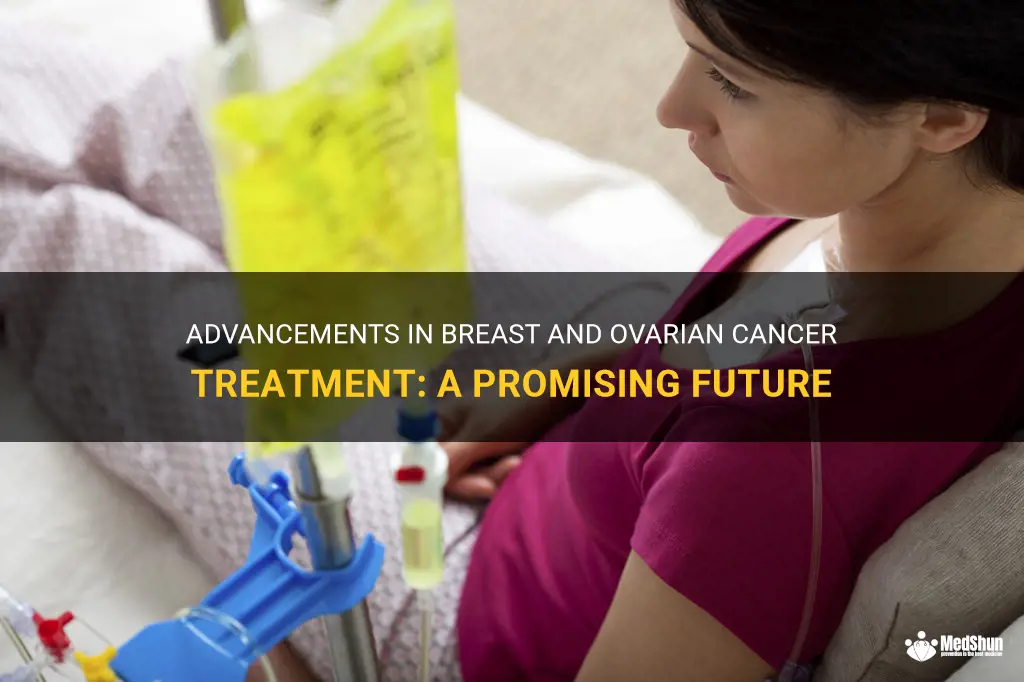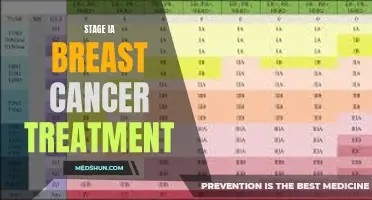
Breast and ovarian cancer are two of the most prevalent types of cancer affecting women worldwide. The treatment options for these cancers have seen significant advancements in recent years, providing hope and improved outcomes for patients. From targeted therapies to precision medicine, the field of oncology has made remarkable progress in fighting these aggressive diseases. In this article, we will explore the latest in breast and ovarian cancer treatment, including emerging treatments and innovative approaches that are changing the way we approach these devastating illnesses. Join us as we delve into the world of breast and ovarian cancer treatment and discover the cutting-edge strategies that are transforming the lives of countless women around the globe.
| Characteristics | Values |
|---|---|
| Type of cancer | Breast, Ovarian |
| Treatment options | Surgery, Chemotherapy, Radiation Therapy, Hormone Therapy, targeted therapy |
| Common surgery options | Lumpectomy, Mastectomy, Oophorectomy, Hysterectomy |
| Chemotherapy drugs | Adriamycin (Doxorubicin), Cyclophosphamide, Paclitaxel, Docetaxel, Carboplatin, Cisplatin |
| Radiation therapy options | External beam radiation, Brachytherapy |
| Hormone therapy options | Tamoxifen, Aromatase inhibitors, Fulvestrant |
| Targeted therapy options | Trastuzumab, Lapatinib, Olaparib, Niraparib, Rucaparib |
| Duration of treatment | Several months to years |
| Side effects of treatment | Fatigue, Nausea, Hair loss, Weight changes, Menopausal symptoms, Infertility |
| Follow-up care | Regular check-ups, Imaging tests, Blood tests |
| Prognosis | Varies based on stage and other factors |
| Supportive care | Palliative care, Support groups, Counselling |
| Clinical trials | Investigational therapies, Research studies |
| Cost of treatment | Varies based on location and type of treatment |
| Insurance coverage | Coverage may vary, check with insurance provider |
What You'll Learn
- What are some of the most common treatment options for breast and ovarian cancer?
- How does the choice of treatment differ between breast and ovarian cancer patients?
- What are the potential side effects and risks associated with the various treatments for these types of cancer?
- Are there any alternative or complementary treatments that can be used alongside conventional methods for breast and ovarian cancer?
- How does a patient's personal history and genetic makeup impact their treatment options and outcomes for breast and ovarian cancer?

What are some of the most common treatment options for breast and ovarian cancer?
Breast cancer and ovarian cancer are two of the most common types of cancer that affect women. While the best treatment approach varies depending on the specific characteristics of each case, there are some common treatment options that are often used for these types of cancer.
- Surgery: Surgery is usually the first step in the treatment of both breast and ovarian cancer. In breast cancer, the surgical options include lumpectomy (removal of the tumor and a small margin of healthy tissue) or mastectomy (removal of the entire breast). In ovarian cancer, surgery involves removing the affected ovary or ovaries, as well as any nearby lymph nodes or other affected tissues.
- Radiation therapy: Radiation therapy uses high-energy rays to kill cancer cells and shrink tumors. It is often used after surgery to destroy any remaining cancer cells in the breast or surrounding area. In ovarian cancer, radiation therapy is less commonly used, but may be considered in certain cases where the cancer has spread to nearby tissues.
- Chemotherapy: Chemotherapy involves the use of drugs to kill cancer cells throughout the body. It is typically used after surgery to destroy any remaining cancer cells and reduce the risk of the cancer coming back. Chemotherapy may also be used before surgery to shrink tumors and make them easier to remove. In some cases, targeted therapy may be used in conjunction with chemotherapy to specifically target cancer cells while minimizing damage to healthy cells.
- Hormone therapy: Hormone therapy is used in breast cancer cases where the cancer is hormone-receptor positive, meaning it feeds on estrogen or progesterone. This treatment aims to block the effects of these hormones or lower their levels in the body, in order to slow down or stop the growth of the cancer. Common hormone therapy drugs include tamoxifen, aromatase inhibitors, and ovarian suppression medications.
- Targeted therapy: Targeted therapy is a newer approach that focuses on specific genetic mutations or proteins present in cancer cells. By targeting these specific molecular features, targeted therapy aims to block the growth and spread of cancer cells while causing less harm to healthy cells. Some targeted therapies are approved for use in both breast and ovarian cancer, such as PARP inhibitors for certain types of ovarian cancer and HER2-targeted therapies for HER2-positive breast cancer.
It is important to note that the treatment approach for breast and ovarian cancer can vary greatly depending on the stage of the cancer, the specific characteristics of the tumor, and the individual patient's overall health. Treatment plans are typically tailored to each patient's unique situation, and may involve a combination of the above options. It is always recommended to consult with a healthcare professional to determine the most appropriate treatment approach for an individual case of breast or ovarian cancer.
The Best Approaches to Treating Grade 1 Breast Cancer: A Comprehensive Guide
You may want to see also

How does the choice of treatment differ between breast and ovarian cancer patients?
Breast and ovarian cancer are two types of cancer that affect the female reproductive system. While they share some similarities, such as being hormone-related cancers, the choice of treatment for these two types of cancer can differ significantly. In this article, we will explore how the choice of treatment differs between breast and ovarian cancer patients.
Diagnosis:
Both breast and ovarian cancer can be detected through various diagnostic tools, such as imaging tests, biopsies, and blood tests. However, the two cancers often require different diagnostic methods. Breast cancer is typically diagnosed through mammography or ultrasound, followed by a biopsy to confirm the diagnosis. On the other hand, ovarian cancer is usually diagnosed through imaging tests like ultrasound or computed tomography (CT) scan, and the confirmation is done by a biopsy or a surgery known as exploratory laparotomy.
Surgery:
Surgery is a common treatment option for both breast and ovarian cancer. However, the type of surgery performed may vary. For breast cancer, the surgical options include lumpectomy (removal of the tumor only) or mastectomy (removal of the entire breast). The choice of surgery depends on factors such as the stage and size of the tumor, as well as the patient's preferences. In ovarian cancer, the main type of surgery is called debulking surgery, which involves removing as much of the tumor as possible. This may include the removal of the ovaries, fallopian tubes, uterus, and nearby lymph nodes.
Chemotherapy:
Chemotherapy is commonly used as a treatment option for both breast and ovarian cancer. However, the drugs used and the timing of chemotherapy may differ between the two. In breast cancer, chemotherapy is usually given after surgery to eliminate any remaining cancer cells and reduce the risk of recurrence. The specific chemotherapy drugs depend on the individual case, but common drugs include anthracyclines and taxanes. In ovarian cancer, chemotherapy is often given before surgery to shrink the tumor and make it easier to remove during surgery. The drugs used for ovarian cancer may include platinum-based agents (such as cisplatin or carboplatin) and taxanes.
Targeted Therapy:
Targeted therapy is a type of treatment that specifically targets cancer cells, minimizing damage to healthy cells. In breast cancer, targeted therapy may be used in cases where the cancer cells have specific genetic mutations, such as HER2-positive breast cancer. Drugs like trastuzumab (Herceptin) can target the HER2 protein and inhibit the growth of cancer cells. In ovarian cancer, targeted therapy options are currently limited. However, research is ongoing to identify potential targets in ovarian cancer cells for the development of targeted therapies.
Hormone Therapy:
Hormone therapy is a treatment option for breast cancer patients whose tumors are hormone receptor-positive. This means that the cancer cells have receptors for estrogen or progesterone, which can stimulate their growth. Hormone therapy aims to block these hormone receptors or reduce the production of hormones to slow down the growth of the tumor. In ovarian cancer, hormone therapy is not a standard treatment option, as the majority of ovarian cancers are not hormone-dependent.
In conclusion, while breast and ovarian cancer are both hormone-related cancers affecting the female reproductive system, the choice of treatment can differ significantly. The differences lie in the diagnostic methods, the type of surgery performed, the timing and choice of chemotherapy, the use of targeted therapy, and the inclusion of hormone therapy. Treatment decisions are based on various factors, such as the stage and type of cancer, the patient's overall health, and individual preferences. It is crucial for patients to work closely with their healthcare team to determine the most appropriate treatment plan for their specific condition.
A Breakthrough Approach: Autoimmune Treatments for Breast Cancer in Lexington, Kentucky
You may want to see also

What are the potential side effects and risks associated with the various treatments for these types of cancer?
Cancer is a complex disease, and there are numerous types of cancer that require different treatment approaches. The potential side effects and risks associated with these treatments vary depending on the type and stage of cancer, as well as the treatment modality being used. In this article, we will explore the potential side effects and risks associated with the various treatments for cancer, focusing on surgery, chemotherapy, radiation therapy, targeted therapy, and immunotherapy.
Surgery is often the primary treatment for localized cancer. Although surgery is generally safe, there are potential risks and side effects associated with this approach. Common side effects include pain, infection, bleeding, and scarring. In some cases, surgery might result in damage to surrounding tissues or organs, leading to complications such as organ dysfunction or loss of function. Additionally, there is always a risk of anesthesia-related complications during surgery, especially in older individuals or those with underlying health conditions.
Chemotherapy involves the use of drugs to kill cancer cells or stop their growth. Chemotherapy drugs can have various side effects, including nausea, vomiting, hair loss, fatigue, weakened immune system, and increased risk of infection. Some chemotherapy drugs can also cause organ damage, such as kidney or liver toxicity. Additionally, chemotherapy can lead to long-term side effects, such as infertility or secondary cancers, although the risk varies depending on the type of chemotherapy drugs used.
Radiation therapy uses high-energy radiation to destroy cancer cells. Common side effects of radiation therapy include skin irritation, fatigue, hair loss (in the treated area), and temporary or permanent damage to nearby organs or tissues, depending on the treatment site. In some cases, radiation therapy can lead to long-term complications, such as an increased risk of developing a secondary cancer in the treated area.
Targeted therapy is a type of cancer treatment that uses drugs or other substances to specifically target cancer cells while minimizing damage to healthy cells. Common side effects of targeted therapy include diarrhea, skin problems, high blood pressure, and liver or kidney problems, depending on the specific drug used. Some targeted therapies can also have cardiovascular or gastrointestinal side effects, although these are less common.
Immunotherapy utilizes the body's immune system to fight cancer. Although immunotherapy has shown promising results in certain types of cancer, it can also lead to side effects, known as immune-related adverse events (irAEs). Common irAEs include rash, flu-like symptoms, diarrhea, and thyroid dysfunction. In rare cases, immunotherapy can cause severe autoimmune reactions, leading to inflammation in various organs, such as the lungs, liver, or colon.
It is essential to note that the side effects and risks associated with cancer treatment can vary from person to person and depend on several factors, such as age, overall health, treatment dose, and duration. It is crucial for patients to discuss the potential side effects and risks with their healthcare team to make informed decisions about their treatment options. Healthcare providers can provide supportive care measures or adjust treatment plans to minimize side effects and enhance the overall quality of life for cancer patients.
In conclusion, while cancer treatments have shown great potential in improving patient outcomes, they are not without risks and side effects. Understanding and managing these potential risks is crucial to ensure the best possible treatment results for cancer patients. By staying informed and working closely with their healthcare team, cancer patients can make informed decisions and receive the necessary support throughout their treatment journey.
Addressing the Issue of Feeling Light-Headed After Breast Cancer Treatment Ends
You may want to see also

Are there any alternative or complementary treatments that can be used alongside conventional methods for breast and ovarian cancer?
Breast and ovarian cancer are some of the most common types of cancer affecting women worldwide. Traditional treatments for these cancers typically involve surgery, chemotherapy, radiation therapy, and hormone therapy. While these methods have been proven effective in many cases, some patients may be interested in exploring alternative or complementary treatments alongside conventional methods.
It's important to note that alternative or complementary treatments should not be used as a substitute for conventional medical treatments. However, some of these treatments may help manage symptoms, improve quality of life, and provide additional support during cancer treatment. Here are a few examples of alternative and complementary treatments that have shown promise in breast and ovarian cancer care:
- Acupuncture: Acupuncture is a traditional Chinese medicine technique that involves inserting thin needles into specific points on the body. It is believed to restore the flow of energy and promote healing. Studies have shown that acupuncture can help manage symptoms such as pain, nausea, and fatigue in cancer patients.
- Mind-body techniques: Techniques such as meditation, yoga, and tai chi can help reduce stress, anxiety, and improve overall well-being. These practices have been shown to have a positive impact on quality of life and may help patients cope with the emotional and physical challenges of cancer treatment.
- Herbal and dietary supplements: Some herbal supplements, such as turmeric and green tea, have shown potential in preventing and treating cancer. However, it's important to consult with a healthcare professional before taking any herbal or dietary supplements, as they may interact with other medications or treatments.
- Massage therapy: Massage therapy can help reduce pain, anxiety, and improve sleep in cancer patients. It can also help alleviate treatment-related side effects such as lymphedema or scar tissue.
- Support groups and counseling: Connecting with others who have gone through similar experiences can be invaluable in coping with the emotional aspects of cancer treatment. Support groups and counseling can provide a safe space to share feelings, fears, and receive support from others who understand.
It's essential to approach alternative or complementary treatments with caution and consult with a healthcare professional before incorporating them into your care plan. It's important to ensure that these treatments are safe and do not interfere with conventional treatments or medications.
In conclusion, while there is no alternative or complementary treatment that can cure breast or ovarian cancer on its own, some of these treatments may help manage symptoms, improve quality of life, and provide additional support during conventional cancer treatments. It's important to work closely with your healthcare team to determine the most appropriate treatment plan for your specific case.
Julia Louis-Dreyfus's Journey: Breast Cancer Treatment and Beyond
You may want to see also

How does a patient's personal history and genetic makeup impact their treatment options and outcomes for breast and ovarian cancer?
Breast and ovarian cancer are two of the most common cancers affecting women worldwide. The treatment options and outcomes for these diseases can vary significantly depending on a patient's personal history and genetic makeup. Understanding these factors is crucial for providing personalized medicine and improving patient outcomes.
Personal history plays a significant role in determining the treatment options for breast and ovarian cancer. For example, a woman who has a family history of breast or ovarian cancer may be at higher risk for developing these diseases. In such cases, preventive measures like regular screening and genetic testing may be recommended. Genetic testing can identify specific gene mutations, such as BRCA1 and BRCA2, which are associated with an increased risk of breast and ovarian cancer. Knowing a patient's genetic risk can help guide treatment decisions and may lead to more aggressive interventions, such as prophylactic surgery or targeted therapies.
In addition to personal history, a patient's genetic makeup can also impact their treatment options and outcomes for breast and ovarian cancer. Genetic mutations can have an impact on treatment response and drug metabolism. For example, some mutations can make certain cancer cells resistant to chemotherapy drugs, while others may make cells more sensitive to specific targeted therapies. Genetic testing can help identify these mutations and guide treatment decisions.
Furthermore, genetic testing can also help determine a patient's prognosis. Certain genetic markers are associated with a higher risk of disease recurrence and poor survival outcomes. Knowing this information can help oncologists tailor treatment plans and monitor patients more closely.
Real-life experiences provide valuable insights into how personal history and genetic makeup impact treatment options and outcomes for breast and ovarian cancer. Take the case of Sarah, a 45-year-old woman with a family history of breast cancer. Sarah undergoes genetic testing and is found to carry a BRCA1 mutation, which significantly increases her risk of developing breast and ovarian cancer. Based on this information, Sarah's healthcare team recommends a preventive mastectomy and oophorectomy to reduce her risk. Sarah decides to undergo these surgeries and is subsequently monitored closely for any signs of disease recurrence. Thanks to this personalized approach, Sarah's risk of developing breast and ovarian cancer is significantly reduced, and she has a better chance of long-term survival.
In summary, a patient's personal history and genetic makeup have a substantial impact on their treatment options and outcomes for breast and ovarian cancer. Understanding these factors allows for personalized medicine, including preventive measures, targeted therapies, and closer monitoring. Genetic testing plays a crucial role in identifying high-risk patients, guiding treatment decisions, and predicting prognosis. By utilizing this information, healthcare professionals can improve patient outcomes and provide the most effective and tailored care for individuals with breast and ovarian cancer.
Advancements in Targeted Therapy for Advanced Breast Cancer: A Promising Treatment Approach
You may want to see also
Frequently asked questions
The treatment options for breast and ovarian cancer may vary depending on the stage of the cancer, the patient's overall health, and other factors. Common treatment options for breast cancer include surgery to remove the tumor, radiation therapy to destroy cancer cells, chemotherapy to kill cancer cells throughout the body, and hormone therapy to block the effects of certain hormones that can promote the growth of breast cancer. For ovarian cancer, treatment options may include surgery to remove the tumor and affected tissue, chemotherapy to kill cancer cells, and targeted therapy to block the growth of cancer cells.
While alternative and complementary therapies may be used alongside traditional cancer treatments, it's important to remember that these treatments should not replace standard medical care. Some alternative or complementary treatments that may be used to manage symptoms or improve well-being include acupuncture, massage therapy, yoga, and meditation. It is crucial for patients to discuss these treatments with their healthcare team to ensure they are safe and effective for their individual situation.
Breast and ovarian cancer treatments can cause a range of side effects, including fatigue, nausea, hair loss, and emotional distress. Managing these side effects is an important part of the treatment process. Certain strategies may help alleviate these side effects, such as getting enough rest, eating a healthy diet, staying hydrated, and engaging in regular physical activity. Additionally, medications may be prescribed to manage specific side effects, and support groups or counseling can provide emotional support during this time. It's crucial for patients to communicate any side effects they may be experiencing to their healthcare team, as they can often offer guidance and support to help manage them effectively.







